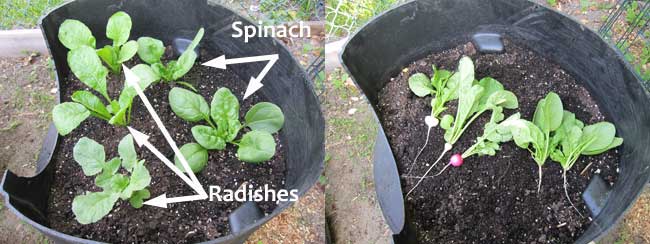Like all radishes, these Valentine's Day radishes are easy to grow and have a fast seed to harvest time. Their multi-colored roots and varied foliage add color, texture, and contrast to any salad plate.
We've grown radishes in raised beds before but only enjoyed moderate success. I'm pretty sure it was a combination of sandy soil and flea beetles that reduced the harvest, so this year we tried planting some organic Valentine's Day radishes (from High Mowing Seeds) in a large container and they did very well. The container soil was a 50/50 mix of potting soil to garden soil, with most of the potting soil mixed into the top 6" of the container. There's also a layer of gravel on the bottom of the container to ensure good drainage. The only fertilizer used was one weak application of Happy Frog's All Purpose 5-5-5 Fertilzer which was mixed into the soil a week or so prior to sowing the seeds.

Radishes are a cool-weather crop and need about 30 days from direct seeding to harvest. Even though they need cool weather they also prefer full sun, or at least mostly sun. The radish seeds were sown at the end of April about 2" apart and thinned to the three radishes you see in the photo above. The radishes did well, but we should have planted them earlier because the weather turned unseasonably warm just as the radishes were maturing at the end of May. Radishes can turn bitter once the warm weather hits.
There were only three radishes so it's not a very accurate radish taste-test but the red radish was perfect, with good crunch and a pleasing bite. The white radish had the same nice crunch but it was too peppery for our taste. Maybe the high temperature affected the white radishes more than the red ones. The radish greens looked and tasted great, and there was no noticeable difference in taste between the different foliage. The seed pack indicated pink, white, and red radishes but since we only planted three seeds the colors were limited to one red and two white. The foliage seemed to indicate the color of the roots but we won't know for sure until they're planted again this fall.